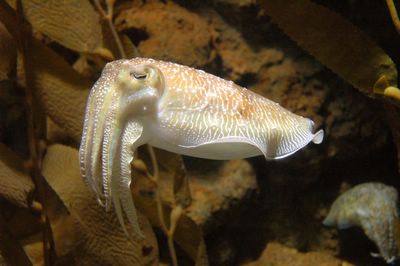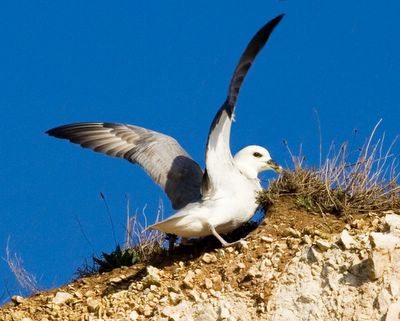September 26 2006. Between 6.10 and 6.20 hrs. G.M.T. the last of the 25 cuttlebones found and refloated without drying in March 24 to April 3 sank in the seawater tanks. A few 10 mm long fragments of reed collected with them have remained floating, although many hundreds sank within a few days. Data for the Whelk egg cases also stranded around that time showed no correlation with their size and a wide variation on a shorter time-scale (e.g. 12 ranged from 1.6 to 54.65 days, with an average of 38.0 days). Intact cuttlebones of the same species and morphology would be expected to show a linear correlation between floatation time and length, due to the volume of gas being extracted and replaced by seawater via the porous surface area of the striated ventral chamber openings. Judging from results in my article in
The Drifting Seed (2006) a large cuttlebone from the North Sea floats for four years in the test conditions reviewed here and the small shells stranded in March might float for one year or more. However, these predictions are modified by breakage and puncturing of the shells by fulmars presumably while the shell is still associated with the floating corpse of this squid-like animal. Moreover, some water is present inside the shell in life and more soon enters when they are punctured before stranding on an uncertain time-scale. Finally on arrival on the beach the shells tend to break in half and undergo further damage which makes them non-buoyant within a few days. Nonetheless the experimental floatation time is instructive as a guide to the possible transatlantic dispersal of these shells after death and presents some statistical problems due to the wide variation in observed times. In the latest test the original size of the shells is evident from their width, inclusive of their chitinous margin when intact and only ranged from 22 to 39 mm (Av. 30.4). The preserved length of these shells with a probable original length of up to 100 mm averaged 62.7 mm and the ratio of it divided by the with was more proportional to the floatation time than the absolute preserved length ranging from 35 mm (sank 14.4 days) to 96 mm (sank 122.4 days). However, the correlation was still poor, probably because the birds produced many deep punctures in some shells without breaking them. Since the sample was 25 one can remove the median result of 107.3 days, corresponding to the average of 91.0 days, and consider the averages and range in four subsets of six shells. The rapidly sunk set ranged from about 4.6 to 24.0 days (
i.e. when they sank in the night, the time was recorded half-way through it) with a mean of 11.7 days and a length/width ratio averaging 1.89 to one. The next six averaged 44.5 days and 1.92 to one. The next six with times greater than the median sample averaged 128.8 days and 2.32 to one, mainly because they were more intact. Finally the six with the longest times, ranging from about 158.1 to 185.4 days average 176.5 days and a length ratio of 2.44 to one. Overall the average floatation time of 91.0 days occupied a rather rare period in a polymodal distribution with the four sunk between 182.2 and 185.4 days perhaps close to the limit for these damaged small cuttlebones?

a cuttlefish


Northern Fulmar (
Fulmarus glacialis) landing on a cliff top at Hunstanton, Norfork, England. Photograph copyrighted Andrew Dunn, 18 February 2006 (http://www.andrewdunnphoto.com). This file is licensed under Creative Commons Attribution ShareAlike 2.0 License





No comments:
Post a Comment